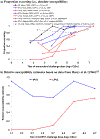Expert review on poliovirus immunity and transmission
- PMID: 22804479
- PMCID: PMC7896540
- DOI: 10.1111/j.1539-6924.2012.01864.x
Expert review on poliovirus immunity and transmission
Abstract
Successfully managing risks to achieve wild polioviruses (WPVs) eradication and address the complexities of oral poliovirus vaccine (OPV) cessation to stop all cases of paralytic poliomyelitis depends strongly on our collective understanding of poliovirus immunity and transmission. With increased shifting from OPV to inactivated poliovirus vaccine (IPV), numerous risk management choices motivate the need to understand the tradeoffs and uncertainties and to develop models to help inform decisions. The U.S. Centers for Disease Control and Prevention hosted a meeting of international experts in April 2010 to review the available literature relevant to poliovirus immunity and transmission. This expert review evaluates 66 OPV challenge studies and other evidence to support the development of quantitative models of poliovirus transmission and potential outbreaks. This review focuses on characterization of immunity as a function of exposure history in terms of susceptibility to excretion, duration of excretion, and concentration of excreted virus. We also discuss the evidence of waning of host immunity to poliovirus transmission, the relationship between the concentration of poliovirus excreted and infectiousness, the importance of different transmission routes, and the differences in transmissibility between OPV and WPV. We discuss the limitations of the available evidence for use in polio risk models, and conclude that despite the relatively large number of studies on immunity, very limited data exist to directly support quantification of model inputs related to transmission. Given the limitations in the evidence, we identify the need for expert input to derive quantitative model inputs from the existing data.
© 2012 Society for Risk Analysis.
Figures







Similar articles
-
Review and assessment of poliovirus immunity and transmission: synthesis of knowledge gaps and identification of research needs.Risk Anal. 2013 Apr;33(4):606-46. doi: 10.1111/risa.12031. Epub 2013 Mar 28. Risk Anal. 2013. PMID: 23550968 Free PMC article. Review.
-
Managing population immunity to reduce or eliminate the risks of circulation following the importation of polioviruses.Vaccine. 2015 Mar 24;33(13):1568-77. doi: 10.1016/j.vaccine.2015.02.013. Epub 2015 Feb 18. Vaccine. 2015. PMID: 25701673 Free PMC article.
-
Sequential inactivated (IPV) and live oral (OPV) poliovirus vaccines for preventing poliomyelitis.Cochrane Database Syst Rev. 2019 Dec 5;12(12):CD011260. doi: 10.1002/14651858.CD011260.pub2. Cochrane Database Syst Rev. 2019. PMID: 31801180 Free PMC article.
-
Eradicating polio: how the world's pediatricians can help stop this crippling illness forever.Pediatrics. 2015 Jan;135(1):196-202. doi: 10.1542/peds.2014-3163. Pediatrics. 2015. PMID: 25548328
-
Transmissibility and persistence of oral polio vaccine viruses: implications for the global poliomyelitis eradication initiative.Am J Epidemiol. 1999 Nov 15;150(10):1001-21. doi: 10.1093/oxfordjournals.aje.a009924. Am J Epidemiol. 1999. PMID: 10568615 Review.
Cited by
-
A literature review and evidence-based evaluation of the Dutch national immunisation schedule yield possibilities for improvements.Vaccine X. 2024 Sep 26;20:100556. doi: 10.1016/j.jvacx.2024.100556. eCollection 2024 Oct. Vaccine X. 2024. PMID: 39444596 Free PMC article. Review.
-
Trade-offs of different poliovirus vaccine options for outbreak response in the United States and other countries that only use inactivated poliovirus vaccine (IPV) in routine immunization.Vaccine. 2024 Feb 6;42(4):819-827. doi: 10.1016/j.vaccine.2023.12.081. Epub 2024 Jan 12. Vaccine. 2024. PMID: 38218668 Free PMC article. Review.
-
Complexity of options related to restarting oral poliovirus vaccine (OPV) in national immunization programs after OPV cessation.Gates Open Res. 2023 Apr 17;7:55. doi: 10.12688/gatesopenres.14511.1. eCollection 2023. Gates Open Res. 2023. PMID: 37547300 Free PMC article.
-
Cost-effectiveness of various immunization schedules with inactivated Sabin strain polio vaccine in Hangzhou, China.Front Public Health. 2022 Sep 23;10:990042. doi: 10.3389/fpubh.2022.990042. eCollection 2022. Front Public Health. 2022. PMID: 36211670 Free PMC article.
-
Health economic analysis of vaccine options for the polio eradication endgame: 2022-2036.Expert Rev Vaccines. 2022 Nov;21(11):1667-1674. doi: 10.1080/14760584.2022.2128108. Epub 2022 Oct 5. Expert Rev Vaccines. 2022. PMID: 36154436 Free PMC article.
References
-
- World Health Assembly. Global eradication of poliomyelitis by the year 2000 (resolution 41.28) Geneva: World Health Organization; 1988. http://www.who.int/csr/ihr/polioresolution4128en.pdf
-
- World Health Organization. Global Polio Eradication Initiative - Strategic Plan 2010-2012. Geneva; 2010. Report No.: WHO/Polio/10.01.
-
- World Health Assembly. Poliomyelitis: Mechanism for management of potential risks to eradication (resolution 61.1). Geneva: World Health Organization; 2008. http://apps.who.int/gb/ebwha/pdf_files/WHA61-REC1/A61_Rec1-part2-en.pdf
-
- Sangrujee N, Duintjer Tebbens RJ, Cáceres VM, Thompson KM. Policy decision options during the first 5 years following certification of polio eradication. Medscape General Medicine 2003;5(4):35. - PubMed
Publication types
MeSH terms
Substances
Grants and funding
LinkOut - more resources
Full Text Sources
Medical
Miscellaneous

